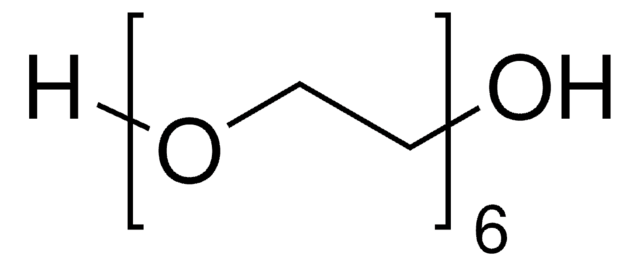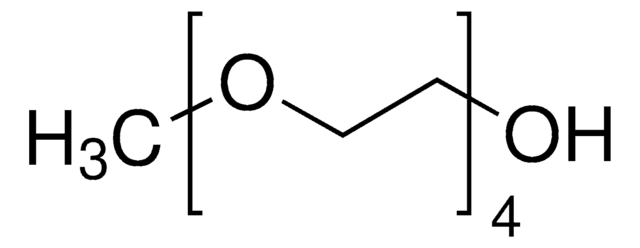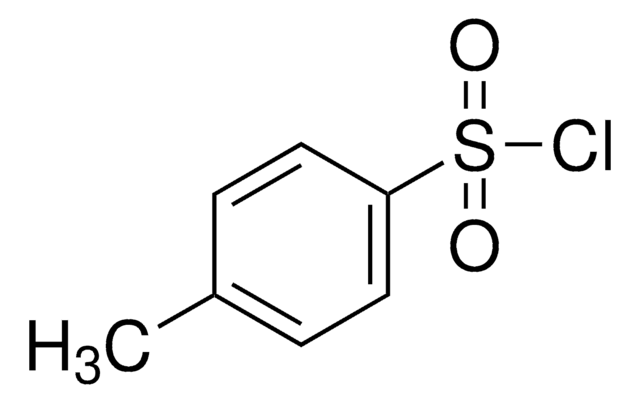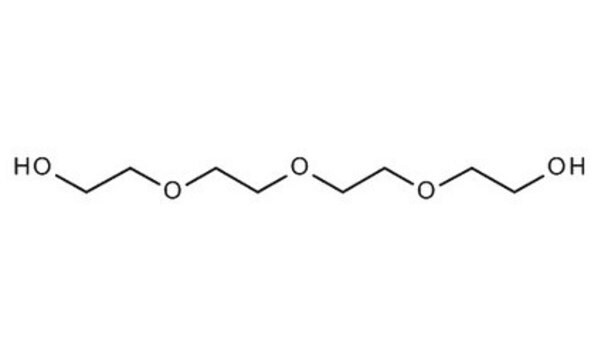110175
Tetraethylene glycol
99%
Sinonimo/i:
Bis[2-(2-hydroxyethoxy)ethyl] ether, Tetra(ethylene glycol), Tetraglycol
About This Item
Prodotti consigliati
Densità del vapore
6.7 (vs air)
Livello qualitativo
Tensione di vapore
<0.01 mmHg
Saggio
99%
PM
average Mn 200
Indice di rifrazione
n20/D 1.459 (lit.)
P. eboll.
314 °C (lit.)
Punto di fusione
−5.6 °C (lit.)
Densità
1.125 g/mL at 25 °C (lit.)
Estremità Ω
hydroxyl
Estremità α
hydroxyl
Stringa SMILE
OCCOCCOCCOCCO
InChI
1S/C8H18O5/c9-1-3-11-5-7-13-8-6-12-4-2-10/h9-10H,1-8H2
UWHCKJMYHZGTIT-UHFFFAOYSA-N
Cerchi prodotti simili? Visita Guida al confronto tra prodotti
Descrizione generale
Applicazioni
Glow discharge plasma deposition of TEG renders surfaces resistant to protein adsorption and cellular attachment.
Avvertenza
Codice della classe di stoccaggio
10 - Combustible liquids
Classe di pericolosità dell'acqua (WGK)
WGK 2
Punto d’infiammabilità (°F)
359.6 °F - closed cup
Punto d’infiammabilità (°C)
182 °C - closed cup
Dispositivi di protezione individuale
Eyeshields, Gloves, multi-purpose combination respirator cartridge (US)
Scegli una delle versioni più recenti:
Possiedi già questo prodotto?
I documenti relativi ai prodotti acquistati recentemente sono disponibili nell’Archivio dei documenti.
I clienti hanno visto anche
Articoli
Dmitri Simberg (University of Colorado Anschutz Medical Campus, USA) reviews the used of dextran and cyclodextrin for the synthesis of nanoparticles used in drug delivery applications.
Dmitri Simberg (University of Colorado Anschutz Medical Campus, USA) reviews the used of dextran and cyclodextrin for the synthesis of nanoparticles used in drug delivery applications.
Professor Randal Lee (University of Houston, USA) discusses design considerations for iron oxide magnetic nanospheres and nanocubes used for biosensing, including synthetic procedures, size, and shape. The effects of these variables are discussed for various volumetric-based and surface-based detection schemes.
Protocolli
99%; Glycerol, ≥99.5%; Tetraethylene glycol, 99%
Il team dei nostri ricercatori vanta grande esperienza in tutte le aree della ricerca quali Life Science, scienza dei materiali, sintesi chimica, cromatografia, discipline analitiche, ecc..
Contatta l'Assistenza Tecnica.









![Bis[2-(2-chloroethoxy)ethyl] ether ≥99.0% (T)](/deepweb/assets/sigmaaldrich/product/structures/333/320/46ff3398-7a62-42b5-b9bc-0a3d0cb0429c/640/46ff3398-7a62-42b5-b9bc-0a3d0cb0429c.png)
